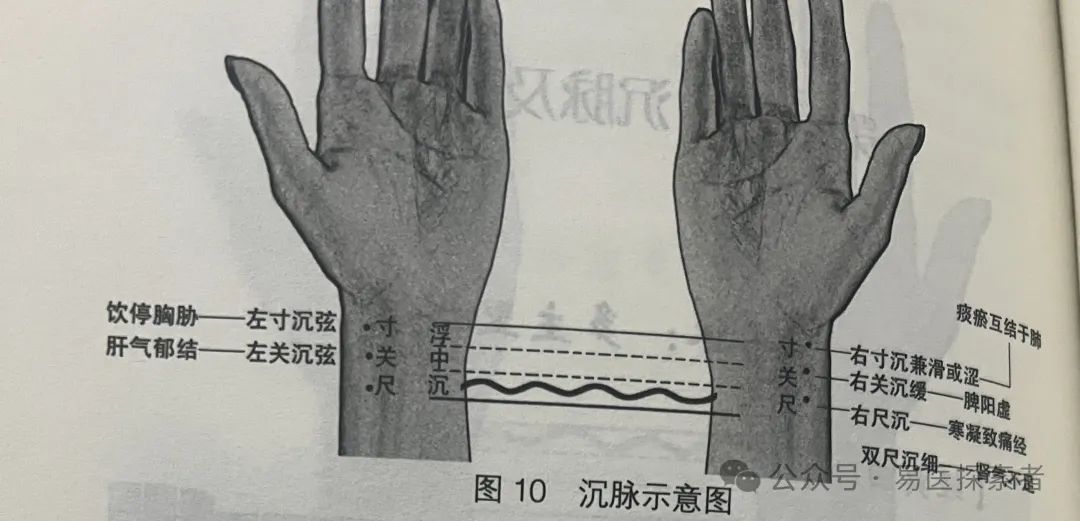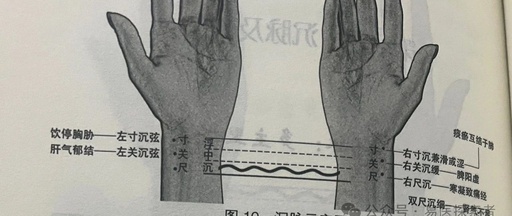
Chen Mai (沉脉), literally understood as a “deep pulse,” refers to a pulse that is felt at the deepest level. When diagnosing Chen Mai, it cannot be detected lightly at the floating level; it can only be clearly felt when pressed heavily at the deep level.
Firstly, Chen Mai does not necessarily indicate a pathological pulse; some normal individuals may also exhibit this pulse type. The specific situations can be divided into the following two categories:
(1)The Chi Mai (尺脉) represents the kidneys and the Ming Men (命门). The kidneys are fundamentally about storage, so the Chi Mai is inherently deeper among the Cun (寸), Guan (关), and Chi (尺) pulses.
(2)If all three positions—Cun, Guan, and Chi—are deep but there are no obvious signs of disease, then this Chen Mai can also be considered a healthy pulse, indicating a special constitution.
Chen Mai is often associated with internal diseases, primarily indicating a Li Zheng (里证). If the pulse is deep and strong, it often indicates internal excess, with pathogenic factors congested internally, leading to a struggle between the righteous and the evil, where the Yang Qi is restrained and unable to promote the pulse Qi outward. Therefore, the pulse is deep and strong, commonly seen in conditions such as Qi stagnation, blood stasis, food accumulation, and phlegm-dampness. If the pulse is deep and weak, it often indicates internal deficiency, with insufficient Qi and blood or Yang deficiency, where the Yang Qi is unable to rise and promote the pulse Qi, resulting in a deep and weak pulse, which can be seen in various organ deficiencies.
(一)Right Cun deep and slippery or wiry—Phlegm and blood stasis in the lungs1. Typical manifestationsA. The body is obese or has a tendency to overeat, experiencing shortness of breath with slight movement. B. Chest tightness, a desire to cough up phlegm but unable to, with discomfort or pain in the stomach area, even vomiting. C. Irritability, difficulty sleeping at night, or poor sleep quality. 2. Possible health issuesPneumonia, lung nodules, pulmonary blood stasis, appendicitis, etc.
3. Treatment principlesFor Chen Mai caused by excessive eating, one should control intake, maintain a light diet, and focus on regulating Qi and resolving phlegm; for Chen Mai due to spleen dampness and obesity, treatment should strengthen the spleen and stomach, and resolve phlegm.
(二)Left Cun deep and wiry—Fluid retention in the chest and hypochondrium1. Typical manifestationsA. Feeling as if the water consumed is stuck in the chest and hypochondrium, and further drinking cannot be swallowed. B. Pain in the chest and hypochondrium, worsening with turning in bed or coughing. 2. Possible health issuesPericardial effusion, pleural effusion, etc. 3. Treatment principlesThe fundamental cause of fluid retention in the chest and hypochondrium is Yang deficiency that cannot transform fluids. Strong individuals who frequently drink cold water in summer may gradually develop this condition. This illustrates how our daily dietary habits have a significant impact. Therefore, one should always pay attention to ensure smooth circulation of Qi and fluids in the body, maintaining a normal relationship between Qi and fluids.
(三)Left Guan deep and wiry—Liver Qi stagnation1. Typical manifestationsA. Introverted personality, easily becoming sullen when faced with issues. B. Distending pain in both hypochondria, with pain in variable locations. 2. Possible health issuesHepatitis, fatty liver, gallstones, breast hyperplasia, uterine fibroids, etc. 3. Treatment principlesLiver Qi stagnation is closely related to emotions; therefore, in addition to dietary and herbal adjustments, attention should also be paid to emotional regulation. Regular communication with others can help alleviate inner anxiety and prevent serious consequences. When initial symptoms such as dry mouth, bitter taste, and pain in the hypochondrium appear, one should pay attention to regulation, focusing on soothing the liver and resolving stagnation, along with emotional care, which can yield good results.
(四)Right Guan deep and slow—Spleen Yang deficiency1. Typical manifestationsA. Frequent vague abdominal pain, loose stools, cold hands and feet. B. The body is inherently weak or has become weak due to prolonged illness.
2. Possible health issuesDiarrhea, chronic gastroenteritis, irritable bowel syndrome, etc. 3. Treatment principlesThis deep and slow pulse primarily indicates spleen Yang deficiency, which can be caused by excessive eating, lack of exercise, overwork, staying up late, and prolonged illness. In real life, many middle-aged and elderly individuals who work in cities and are overweight often have such issues. Additionally, excessive consumption of cold drinks, cold foods, or overeating can damage spleen Yang. Therefore, treatment should focus on warming Yang and strengthening the spleen.
(五)Right Chi deep—Cold accumulation causing dysmenorrhea1. Typical manifestationsA. Menstruation is often delayed, with scanty dark blood clots. B. Severe abdominal pain, not liking pressure, with relief after warmth or hot compresses. C. During dysmenorrhea, the complexion appears pale and bluish, with cold hands and feet, fear of cold, and a white tongue coating. 2. Possible health issuesMenstrual irregularities, adenomyosis, uterine fibroids, etc. 3. Treatment principlesIn Traditional Chinese Medicine, the causes of dysmenorrhea are numerous; here, it primarily reflects dysmenorrhea caused by cold, so treatment should focus on warming the meridians, dispelling cold, and alleviating pain.
(六)Both Chi deep and thin—Kidney Qi deficiency1. Typical manifestationsA. Night sweats, meaning excessive sweating during sleep, with low-grade fever in the evening. B. Premature graying of hair, involuntary leg shaking while sitting. C. In middle-aged and elderly individuals, cold shivering during urination is also a manifestation of kidney Qi deficiency. 2. Possible health issuesVarious forms of premature aging, such as premature ovarian failure, premature graying, etc. 3. Treatment principlesKidney Qi deficiency is a direct cause of premature aging and can also lead to decreased immunity, potentially resulting in various diseases. Treatment should focus on consolidating essence and filling marrow, and one can also consume more black sesame, walnuts, and peanuts.
For those interested in previous articles, you can explore:
Characteristics of the physical constitution of people from the north and south and their medication characteristics
Divination and clarification for patients
Today, I will tell you what the Five Movements and Six Qi are.
People from the north who have suffered from insomnia and palpitations for years find relief in the south (Five Movements and Six Qi)
The impact of the Five Movements and Six Qi in spring and winter on the human body in 2025.
Today’s insights on the Kan Gua (坎卦) (electric blanket)
This month is a peak period for cardiovascular diseases.
Today, I saved a patient with acute myocardial infarction with acupuncture.
Analyzing physical constitution through birth date and time using the Five Movements and Six Qi.
Understanding personality through pulse feeling.
Experiences using the northern and southern pulse methods.
Difficulty breathing, and after three needles, normal breathing was restored in less than a minute.
Using copper coin divination to diagnose diseases, which made me hesitant to treat.
One needle to clear nasal congestion, never missing a chance.
Discussing the physical and mental state of individuals with thin pulses.
Pulse patterns contain personality traits and life trajectories—Slippery pulse section
Pulse patterns contain personality traits and life trajectories—Flooding pulse section
Pulse patterns contain personality traits and life trajectories—Wiry pulse section
Pulse patterns contain personality traits and life trajectories—Tight pulse section
Pulse patterns contain personality traits and life trajectories—Wiry pulse section
Pulse patterns contain personality traits and life trajectories—Long pulse section
Pulse patterns contain personality traits and life trajectories—Deficient pulse section
Pulse patterns contain personality traits and life trajectories—Rapid pulse section
Pulse patterns contain personality traits and life trajectories—Deep pulse section
Pulse patterns contain personality traits and life trajectories—Slow pulse section
The author specializes in the study of the Yijing (易经) and Traditional Chinese Medicine, learning from New Zealand’s Pan Shinan’s new concept of Tian Ying Xue (天应穴平衡针法), navel acupuncture, Huang Di Nei Zhen (黄帝内针), the third Bagua (八卦) acupuncture method, acupuncture and herbal pulse regulation, the Five Movements and Six Qi of northern and southern governance, and has studied under Zhao Yixin, a descendant of the Kongtong Daoist tradition, focusing on body evidence, Daoist suspended needle techniques, and enjoys practicing Qigong and exploring the truth of medicine.
For those interested in communication, add the author’s WeChat: wzh429hh

